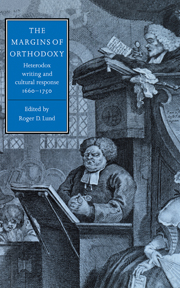Book contents
- Frontmatter
- Contents
- List of contributors
- Acknowledgments
- Introduction
- PART I THE IDEOLOGY AND ORIGINS OF HETERODOXY
- PART II LOCKE AND HETERODOX OPINION
- PART III POLICING THE MARGINS
- 5 Samuel Parker, religious diversity, and the ideology of persecution
- 6 The Societies for the Reformation of Manners: between John Locke and the devil in Augustan England
- 7 Irony as subversion: Thomas Woolston and the crime of wit
- 8 The limits of moderation in a Latitudinarian parson: or, High Church zeal in a low churchman discovere'd
- PART IV ORTHODOX DEFENSES, HETERODOX RESULTS
- Select bibliography
- Index
7 - Irony as subversion: Thomas Woolston and the crime of wit
Published online by Cambridge University Press: 09 October 2009
- Frontmatter
- Contents
- List of contributors
- Acknowledgments
- Introduction
- PART I THE IDEOLOGY AND ORIGINS OF HETERODOXY
- PART II LOCKE AND HETERODOX OPINION
- PART III POLICING THE MARGINS
- 5 Samuel Parker, religious diversity, and the ideology of persecution
- 6 The Societies for the Reformation of Manners: between John Locke and the devil in Augustan England
- 7 Irony as subversion: Thomas Woolston and the crime of wit
- 8 The limits of moderation in a Latitudinarian parson: or, High Church zeal in a low churchman discovere'd
- PART IV ORTHODOX DEFENSES, HETERODOX RESULTS
- Select bibliography
- Index
Summary
As the first work of British philosophy to fully exploit the subversive potential of irony and ridicule, Hobbes's Leviathan was also the first to be reviled for a brilliance of style and subtlety of wit that made it seem virtually “unanswerable.” Deists and freethinkers were quick to find in Leviathan a rhetorical model for their own assaults on priestcraft and political tyranny, abandoning more conventional modes of argumentation for the strategic indirection of irony and wit. The adaptation of irony to the demands of religious and philosophical controversy inspired the systematic defense of ridicule as a test of truth given its most memorable form in Shaftesbury's Essay on the Freedom of Wit and Humor (1708) and Anthony Collins's Discourse of Irony and Wit in Writing (1729). The efflorescence of heterodox wit also elicited angry rejoinders from critics as various as Lord Clarendon, Richard Blackmore, and Mary Astell, all of whom recognized the power of wit to undermine orthodox assumptions.
Treatments of eighteenth-century wit have been limited almost exclusively to discussions of its aesthetic significance, but as we shall see, much of the critical and philosophical debate over the “decorum” of Augustan ridicule disguised a much more fundamental struggle over the very means by which power was to be defended or assailed. This chapter briefly traces the process by which wit first came to be associated with heterodox assaults on established institutions of religion and government, and recounts subsequent attempts to proscribe all forms of rhetorical indirection, including ridicule, innuendo, and wit, as essentially subversive modes of discourse.
- Type
- Chapter
- Information
- The Margins of OrthodoxyHeterodox Writing and Cultural Response, 1660–1750, pp. 170 - 194Publisher: Cambridge University PressPrint publication year: 1995
- 2
- Cited by



